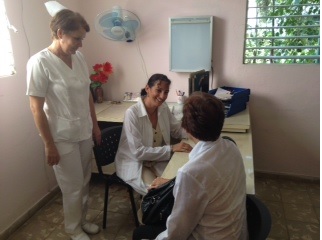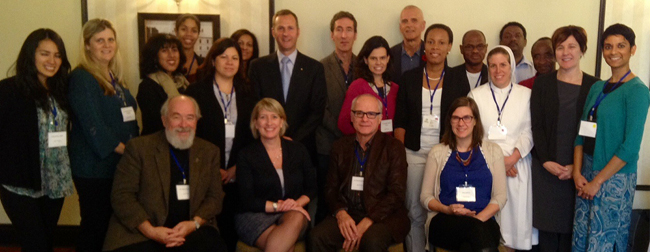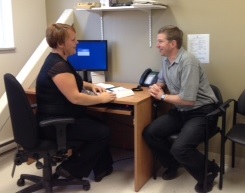From the President: Lessons from Cuba and Canada
español
Cuba and Canada provide lessons on family medicine and universal health coverage
 Family doctor, Katia Medina Matos, lives in Lechuga Village, a small rural community on the island of Cuba. Katia works in partnership with a community nurse, Gladys Garnier Martinez, and together Katia and Gladys provide health care to 844 people based in four rural villages. They know everybody in these four communities. Working together they see 40 patients on average each day, including up to 15 in their own homes. And how do they get from village to village? They walk. Katia and Gladys are supported in their important work by the staff of the polyclinic in the nearby rural town of Managua.
Family doctor, Katia Medina Matos, lives in Lechuga Village, a small rural community on the island of Cuba. Katia works in partnership with a community nurse, Gladys Garnier Martinez, and together Katia and Gladys provide health care to 844 people based in four rural villages. They know everybody in these four communities. Working together they see 40 patients on average each day, including up to 15 in their own homes. And how do they get from village to village? They walk. Katia and Gladys are supported in their important work by the staff of the polyclinic in the nearby rural town of Managua.
Photo: Cuban family doctor, Katia Medina Matos, and primary care nurse, Gladys Garnier Martinez, consulting in their clinic in the rural village of Lechuga in Cuba
I met Katia and Gladys on a recent visit to Cuba. My visit was hosted by Cuban family medicine leaders, Lilia González Cárdenas and Niurka Taureaux Díaz, and by members of the Society of Family Doctors of Cuba.
Cuba is a small island nation with a health system based on primary care that is the envy of many much more wealthy countries. In Cuba 36,000 family doctors cover the health care of 100% of the community of 11 million people. Every person has their own family doctor and primary care nurse team. And this includes teams based in 3000 clinics in rural areas across the country.
Cuba provides one of the best examples of personalised family medicine ensuring every member of the community has access to quality primary health care, delivered by well-trained doctors and nurses.
 Photo: Classic Havana
Photo: Classic Havana
Every Cuban, including every person living in rural areas, has free access to their own primary health doctor and nurse team. These teams of a doctor and a nurse have a list of all people in their community, and they are expected to know the health status of everyone in their community, including the elderly and housebound people in their community, and they will go to visit these people, rather than expecting them to come to their clinics. It is a proactive approach to ensure all people, and especially the most vulnerable, are getting access to the health care they need. Disease prevention is also strongly emphasized as core component of primary care delivery.
The Lancet medical journal recently described how Cuba has an under-5 mortality rate of 5.7 per 1000 live births, below that of the United States of America. Cuba offers a model of cost-efficient and effective primary care that can be adapted by many other countries struggling to provide health care coverage to their entire population.
Cuba also trains more primary care doctors than their own country needs and sends missions of family doctors to areas of need around the world. Most recently Cuba responded immediately following the World Health Organization’s call for international aid and sent 200 doctors to West Africa to assist the fight against the Ebola virus.
In an extraordinary contribution to global health, Cuba’s Medical School of Latin America (Escuela Latinoamericana de Medicina – ELAM) has trained 27,000 young people from disadvantaged communities in 65 countries to become doctors. Established in 1998, ELAM is part of a global movement of socially accountable medical schools dedicated to training medical students to better meet the specific needs of the communities they will serve as doctors. The medical education provided at ELAM emphasises the importance of primary care.
Something Iona Heath, former president of the Royal College of General Practitioners of the United Kingdom, said recently struck a chord with me. Iona said, “I believe that family medicine is a force for good throughout the world.” Our colleagues in Cuba are showing that this is true through the practical example they set each day.
It also strikes me that while many wealthy nations source doctors and nurses from other countries to meet the health care needs of their populations, what they should be doing is following Cuba’s example and training more health care professionals than they need and making a net contribution to the rest of the world. If a small, developing nation like Cuba can make extraordinary contributions like this to humanity, why can’t other nations?
Another country making a substantial difference to global health through supporting family medicine developments around the world is Canada. I was recently invited to Quebec to attend the Sadok Besrour Global Health Conference, hosted by the College of Family Physicians of Canada Research and Education Foundation. Sadok Besrour is a Canada family doctor, originally from Tunisia, who has made a very generous donation to support the work of the members of the College of Family Physicians of Canada in advancing global family medicine.

Photo: WONCA president with delegates to the Sadok Besrour Global Health Conference in Quebec, Canada
Led by family doctor Katherine Rouleau from the Department of Family & Community Medicine at The University of Toronto, the meeting brought together family doctors from many countries including Ethiopia, Haiti, Kenya and Mali, to work with colleagues from across Canada who are providing support for the introduction of family medicine education and training in each of these countries. This global movement is a wonderful example of how we can all get involved in supporting strengthening primary care through family medicine around the world. I was particularly impressed with the work our French-speaking colleagues in Canada are doing with partners in French-speaking nations in Africa.
While in Quebec I also took part in the 60th anniversary celebrations of the College of Family Physicians of Canada (CFPC). I was invited to speak about the contributions that family doctors from Canada have made to WONCA and global family medicine over the past 60 years.
View the President's address to the meeting
 Photo: Canadian family doctor, Marie-Pierre Dumas, meeting with a member of her primary care team in her clinic in Québec
Photo: Canadian family doctor, Marie-Pierre Dumas, meeting with a member of her primary care team in her clinic in Québec
The origins of WONCA can be traced back fifty years to 1964 when the very first World Conference on General Practice was held in Montreal, hosted by the CFPC. WONCA was established officially eight years later, in 1972, and the CFPC was one of the 18 founding member organisations, joining other national colleges of family doctors sharing a commitment to work together to ensure that the people of all countries would have access to well-trained and well-supported family doctors.
 At the first official WONCA meeting in 1972, Donald Rice, one of the leading figures of the CFPC and the second world president of WONCA, said, “we are witnessing a rebirth of the family doctor as the central figure in new patterns of health care delivery. A family doctor trained in modern medicine but with the same compassion, understanding and empathy, so characteristic of the much honoured and revered family doctor of bygone days. A family doctor trained to work with other health professionals in providing total health care for a rapidly changing society.” These are words that continue to be true today as family medicine develops as the core of strengthened health care systems in many parts of the world.
At the first official WONCA meeting in 1972, Donald Rice, one of the leading figures of the CFPC and the second world president of WONCA, said, “we are witnessing a rebirth of the family doctor as the central figure in new patterns of health care delivery. A family doctor trained in modern medicine but with the same compassion, understanding and empathy, so characteristic of the much honoured and revered family doctor of bygone days. A family doctor trained to work with other health professionals in providing total health care for a rapidly changing society.” These are words that continue to be true today as family medicine develops as the core of strengthened health care systems in many parts of the world.
Photo: Cuban family doctor, Katia Medina Matos, sets out by foot on her daily round of home visits to her patients in the four rural villages under her care
Canada and Cuba provide us with exciting examples of the potential for family medicine to ensure health coverage for all people in each nation of the world and demonstrate how much we, as family doctors, can achieve by working together.
Michael Kidd
President
World Organization of Family Doctors (WONCA)